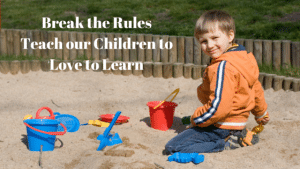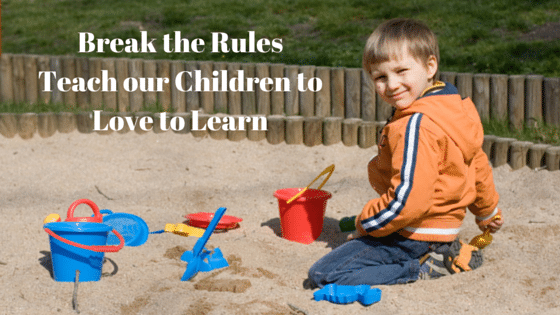By Guest Author Lisa Baker-King
I hate rules. Seriously! I used to wonder why. Looking back, there were a few clues…
(Insert Wayne’s World alternate ending music… )
The time in theology class when I decided to argue like a seasoned trial lawyer with the well-meaning priest who had to be at least 100 years old. I got him so upset that he leaned down, banging on my desk and said with as much restraint as he could muster “young lady I have had about enough of you!” My reaction… I laughed. Stopped laughing when I had to spend the afternoon in the Dean’s office.
 Or the time, I think I was 8 or 10, during a 4H class when the nice volunteer mother had the boys make Balsa Wood racecars and I was assigned to sew a wrap skirt. I remember making her afternoon a living heck, refusing to sew like a good girl and demanding that I get to make a racecar like the boys. To this day, if a button falls off a garment, I take it to the dry cleaner or bribe a friend to sew it on.
Or the time, I think I was 8 or 10, during a 4H class when the nice volunteer mother had the boys make Balsa Wood racecars and I was assigned to sew a wrap skirt. I remember making her afternoon a living heck, refusing to sew like a good girl and demanding that I get to make a racecar like the boys. To this day, if a button falls off a garment, I take it to the dry cleaner or bribe a friend to sew it on.
Don’t get me wrong; there is a time and a place for real rules. Rules, for example, to keep us safe. I am referring to limiting thoughts and actions masking as rules. Ones that society and us unintentionally place on our children, we need to break those rules so that our children can love to learn.
As a rule breaker, family author, and relationship expert, I look for simple and everyday ways we can teach our children to love to learn so that their unique strengths and ways of learning are celebrated.
When we understand our children’s natural talents or strengths, it sets them free to learn in a way that makes learning a joy. So, how do we do that? Sounds complicated…correct? Actually, it’s not hard at all. It starts by watching them play.
Let me tell you a story, it’s the story of four children playing in a sandbox.
Johnny, Megan, Matt, and Christine are very excited. It’s playtime at school. The sun is out as they run from the classroom to the play yard. Their teacher, Miss McMasters, encourages them to build a sand castle in the sandbox.
As they approach the sandbox, Megan stops with her hands on her hips and begins to ask questions. “How big is the castle?” “Remember the last time we built a castle?” “Why are we building a castle?” Megan is our ‘why’ child and she solves problems by gathering information. It’s important for her to know all the facts before getting started. This is a child who might get frustrated at school if simply told to do something. She needs information first and then watch out, she will go to town. Megan loves to learn by collecting information and ‘noodling out’ the answer.
Johnny is not stopping for anything! He has great ideas! Johnny is holding court in the middle of the sand box, gesturing very enthusiastically as he tells his friends all his amazing ideas for the best sand castle ever made. Johnny is our ‘idea’ child. His ideas are imaginative and creative and he is not shy about telling his friends all about them. He can see the castle in his head, complete with a moat and drawbridge. He is a visionary and likes to do things his own way. This is a child who doesn’t pay particular attention to the details of his school homework and will become disheartened if told to do things without the freedom to put his spin on things. Johnny loves to learn by being creative and having the go-ahead to jump in and explore.
Matt is the kid with a plan! He has a process for building the castle. Matt is our ‘process’ child. First you level the sand, then you gather pebbles for a walkway, next you very carefully construct the walls of the castle. His approach is very systematic. Matt needs to be able to sort information and organize it. If asked to ‘wing it’, Matt will get nervous that a mistake will be made. Matt likes to do things one at a time and gets discouraged when expected to ‘multi-task’ or to work without a plan. Matt loves to learn by getting organized and having a plan.
Miss McMasters decides to check in on the little monkeys. As she walks towards the evolving sand castle she notices that Christine is knee deep in the sand, building the castle as if it will stand the test of time. Christine is our ‘demonstrator’ child. Christine likes to get her hands dirty and will get frustrated if the castle is not of the highest quality. When given math homework, her mom knows that numbers need to be more than figures on a piece of paper. Christine needs tangible items like blocks, or something to get her hands on. Christine loves to learn by getting three-dimensional and interacting with her environment.
When we embrace our children’s natural strengths and structure learning in a way that celebrates these talents, they will love to learn and ultimately become the person they were meant to be.
About the author:
Lisa Baker-King is a nationally recognized and televised family author and relationship expert who is creating a movement to connect families and celebrate children. She is passionate about helping children to find their voice while giving parents and adults the tools they need to recognize what is right about them so they can break free and be who they were meant to be.
Join the Journey at www.zebecs.com
Goodreads Book Giveaway
The Zealous Zebecs from the Midnight Ocean’s Zenith
by Lisa Baker-King
Giveaway ends June 15, 2015.
See the giveaway details
at Goodreads.


